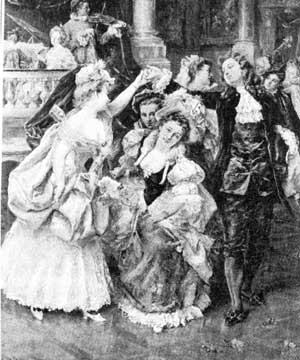
| HOME | MENU | DOCS | SEARCH |
Those dances of the last centuries which were widely adopted far outside the era and a place of emergence are considered as the historical and household. Historical they are called as dances of last time, and also as the dances which became history.
Emergence of dances is connected with labor processes, games, ancient ceremonies, religious holidays. In each district they had the features. The household dances which became historical, represent processing of national dancing material and reflect features of a certain era or Wednesday. Characteristic features of culture are shown in the construction and style of dance, in its music, clothes dancing their manners etc.

The main positions of feet in historical and household dances - the I-st and III-rd, intermediate - II and IV.
In the XVI century the Italian and French dancing-masters, creating technology of dance, paid special attention to style of execution and a manner of the dancing. From the performer the important bearing, a slow measured gait, the prudish and in details developed mutual greetings - bows and curtseys was required. Observance of all these rules not only in dance, but also in life, was considered as a sign of a noble origin and a high social standing. The live and direct movements of national dances were considered as a bad form.
To the ceremonial established in society there corresponded also suits. Men carried camisoles, raincoats (it wasn't necessary to remove) and hats which removed, shifted and again put on during dance. Ladies wore dresses with very long loops (to 5 meters), with a set of folds and difficult headdresses. The general style of a suit was magnificent and heavy, it connected and didn't give freedom to the movements.
In the last centuries of one of the main forms of entertainments of the nobility there were balls and masquerades in the form of balls. Naturally, these dances were rather a fashion show, demonstration of wealth and position of the nobility, than dance. But solemn nature of these dances, desire of a variety even in the movement of columns on the hall introduce various jumps, jumpings up, the sliding steps to dance. Mass interest of the "missing" nobility in dances as to a form of rest and amusement wakened. Dance as esthetically developed leisure form – from now on vital need of the upper class. Honor and praise to those French kings who own example and the power, calculation and wealth managed to transfer the best esthetic and ethical traditions of "a gallant eyelid" to us.
Stories are known brilliant balls and masquerades at the time of Charles IX's reigns, Genrikhov of III and IV, Lyudovikov of XIII and XIV. The office of national and court dances began already since the end of the XV century, at first in Italy, then in France. There are first treatises about dances, attempts of the description of steps and jumps become. In the XV-XVI centuries bassedansa, бранль, processions with bows and salutes are fashionable.
In the XVII-XVIII century naturalness of movements vanishes in dances of aristocrats (a minuet, a fast minuet, a gavotte) (at this particular time there are laws of statement of hands and feet, a regulation of movements of the case – everything that was included into the classical ballet). At balls of the XVII century of idea of beauty of lines were reduced to the principles of the ballet – at balls turnout of feet was considered as grace, hands needed to be held rounded: lifted or lowered, they had to be equally rounded in elbows, the brush is collected, the thumb is taken away under a palm opposite to a middle finger.
At the beginning of the XIX century new live, easy and easier dances (a polonaise, a waltz, экосез, a quadrille, котильон, the Pole, a mazourka) which become the all-European ballroom dances win popularity.
Many dances which appeared in the XX century (the krakowiak, тустеп, a tango, a waltz Boston, a foxtrot, a Charleston, the blues, a rock'n'roll, a point, a samba, a twist, salsa, a mambo, etc.), are popular and today.
Here the selection of historical dances of the different people is presented. For your convenience dances are listed in alphabetical order.
Ball dance - the waltz three together executed by the gentleman and two ladies. The musical size 3/4, was popular in the XIX century at family balls. The movements consist of the easy gliding steps. Special value has the drawing of the hands dancing, changing gracefully and smoothly.
Allemanda - (from fr. allemande, letters. - German), ancient (from XVI century) court French dance of the German origin, smooth, moderate speed, belongs to bassedansa. Musical size 4/4. In this dance at the XVIII century of a hand dancing from usual situation along a body for the first time woke up up. This freedom of hands was also characteristic feature of an allemanda. It also prepared the main positions of a gavotte in which hands become even more tantsevalna.
Ball - (from armor. ballare - to dance also fr. bal), a big dancing-party. In Europe the tradition of secular balls is formed XIV century, and soon balls become an integral part of court feasts. In the XV-XVII centuries of a manner, the rule of behavior and all dancing etiquette were exposed to a strict regulation. On feasts there were special masters of ceremony of a ball specifying who should open a ball who and with whom has to dance, watching behavior and the movement of the dancing. Derogations from rules were reprehensible.
... In pre-Pertine Russia so-called "saloon dances" as in Western Europe wasn't. In towers drove female round dances, and in the people dancings prospered. In general, the relation to "dancings and idleness" was guarded. The change occurred at Peter I who sought to attach the maximum number of people to achievements of European civilization, wished "not simply to borrow, adopt, and to create, original, uniting original with western". Thanks to Petr's transformations the ban on dances within secular communication was lifted. Petr, his spouse Ekaterina and the daughter Elizabeth took part in dances and, according to contemporaries, danced very gracefully.
In 1718 the decree on introduction of assemblies, i.e. meetings balls was issued. Dances in which also elderly people took part were the main entertainment on assemblies. Gentlemen could invite any of the present ladies to dance, it wasn't accepted to refuse.
By new rules of Petrovsky assemblies, each owner of the notable house needed to release a dancing, games and entertainments from time to time. The inability to dance becomes shameful and therefore boyars write out to themselves dance teachers and "secular obkhozhdeniye" which duties were very extensive. The dancing-master had to train in dances (a minuet, a polonaise, a country dance, a pavane, Courant, англез) and at the same time to teach a good form.
By the end of XVII – the beginning of the XVIII centuries finally there is such form of pastime as balls. Dance by all is recognized as very pleasant, irreplaceable entertainment. The ball becomes one of the most important parts of public life. This meeting place and communication. After all house visits impose the mass of restrictions in behavior, besides visit by all means requires any business. And at balls it is possible to meet just like that, and it will be "decently".
From all possible ways of pastime the ball appears the most popular. After all walk of the aristocrat doesn't give the chance for communication because it is made, as a rule, in the carriage; hunting is also inconvenient since it is connected with sitting on a horse. Theater - an excellent invention, it is possible - to show all toilets, conversation messages in deep beds there, to coquet, flirt, but, unfortunately, all this should be done besides the main occupation - contemplation of a show. And only the ball allows though a little to show the dexterity and grace, and also freely "to be published".
Petrovsky reforms made life of society of more harmonious; it wasn't necessary to hide desire to have a good time any more. After all the ball is not only dances, but also games - in the beginning chess, then the Russian society very much fell in love with gamblings. It and a peculiar club where it was possible to communicate to acquaintances; it and marriage office where destinies of the most outstanding dynasties of Russia were decided. Communication was not less important component of a ball, than dances. At balls acquaintances were started, issues of service and career were resolved, the public opinion was formed.

Dance of an era of baroque (the XVIII century) assumes that role which was assumed subsequently by sport: to support culture of a body on an equal basis with culture of spirit. From a baroque era we in inheritance still had the ballet - the difficult, regulated by beauty of plastic lines art which demanded special long training. At the end of XVIII - the beginning of the XIX century the dancing culture becomes the most important component of a social life, and balls - indispensable attribute of noble life. Dance was an obligatory subject in various educational institutions.

During that time in the educated Europe danced everywhere and very much that it is possible to assume that there was in general no business, as soon as dances at all o'clock in the afternoon and nights. Balls official and court, public, family differed. For the sake of a ball sewed the most fashionable dresses, invited the most famous musicians and organized magnificent dinners, because of it reconstructed all daily routine.
Not to dance to the secular person of that time and furthermore to the lady, it was impossible. "Ability to dance and choreographic talent was made by valuable quality and success not only on a parquet, but sometimes and in a field of office career". The ball was fine entertainment, but demanded big physical and emotional forces. On a ball it was required to look, control perfectly each movement and the word and thus to seem natural, friendly and cheerful. The science of ball communication demanded long years of training. Therefore the ball culture was included into human life in a childhood in the form of lessons of dances and visit of children's balls.
The huge part on a ball was assigned to the manager, it was honourable and is responsible: depended on it, whether the ball will make success. The manager tried to show a maximum of the imagination and virtuosity to diversify dancing figures and to give joy to guests. It had to "recover society personal cheerfulness and mood". (1895). Both drawing up couples, and distribution of ball space, and maintenance of an order in a hall belonged to its duties.
The ball a polonaise opened, it in solemn function of the first dance replaced a medieval minuet. Didn't do and without mazourka which became the international ball dance. The waltz became indispensable attribute and the king of balls! How many delightful freedom in the smooth movement! The waltz became way of liberation from conventions which else were still a basis of public life. In the same time there was one more dance which success eclipsed popularity of many others, - the Pole. The ball kotilyony, some kind of final performance of all participants came to the end with dance game. Danced at that time a quadrille and other different types of a country dance.
Balls and dancing-parties of the XIX century are reflected in many classical works of the Russian literature, especially in "Eugene Onegin" of A.S. Pushkin and "War and peace" of L. N. Tolstoy.
The dancing-party is not only the ladies and gentlemen flying in dance, but also low-necked dresses, fans, dress coats, kidskin gloves, scarfs, masks, smiles and a tender look, bow and a kiss of a hand … The dancing space intended not only for dances, but also for fashion show. Ball dresses weren't used more than one - two times and had to look "in the latest fashion".
At the end of the XIX century with changes in public life the ball culture gradually dies away, court balls are held more and more seldom. The last balls and dancing meetings took place in 1914.
In the first years of the Soviet power ballroom dances were proclaimed petty-bourgeois and not corresponding to new cultural policy. There was a tradition of the Soviet mass holidays, with live pyramids and sports parades. The place of dancing-parties in the sphere of leisure became very modest. The "Soviet" household dances, and the dances popular in the world were created forbidden for "bourgeoisness". Difficult drawing of many dances became simpler and became similar to the simple peretoptyvaniye on a place which isn't demanding special training.
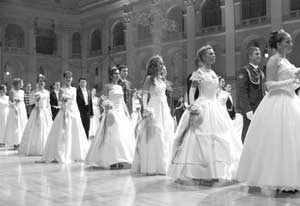
However in the European countries in the high society the tradition of holding balls remained. In the Soviet Union the idea of similar balls was represented impossible, however even here cultural memory had an effect: graduation school dancing-parties steadily were called as "balls" of graduates.
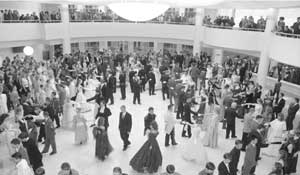
Today the culture of secular balls revives again; dancing-parties, salons and balls become more and more popular. As before, on them meet, get acquainted and communicate (it is possible to come to them even to one). The dances shining last centuries and which are historically executed at balls are again interesting and fashionable, in many respects thanks to the availability, "indiscriminateness", elegance and beauty.
Ball dance (saloon, household) is a dance which serves for mass entertainment and is executed by couple or a large number of participants at dancing-parties (balls). I arose in the XIV century in Italy during blossoming of this country, rules of ball dance of that time, system of record of dance were developed in the same place. Balls in Florence the XV-XVI centuries - an example of magnificence, beauty, an ingenuity. Then, in the XVI-XVII centuries France becomes the legislator of ball dance, the technology of dance becomes complicated. Created in the 60th of the XVII century. The Parisian Academy of dance regulated many years style and manner of performance of "ball choreography". In the XVII century ball dance extended across all Europe.
During that time "low" dances or bassedansa prevailed (a pavane, Courant, an allemand) - with bows, curtseys, salutes, is frequent in the form of processions with candles and torches, accompanied with singing of the dancing. Gradually on balls national dances got and respectively adapted to stiffness and etiquette of the yard and the aristocracy.
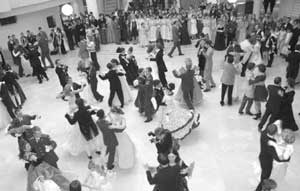
In France eras of baroque it was fashionable to execute the dances going on a scene, i.e. the last novelties of operas and ballets at balls. (You imagine the average level of choreographic preparation of society of that time?) In the XVIII-XIX century France was the fashion-maker for all Europe. The Russian nobility of that time adopted fashions of Paris. It completely belongs and to dances that was promoted by the ballet masters invited at that time from France, dancers, teachers, tutors.
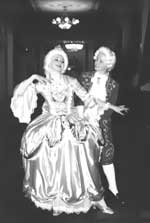
Fashionable dances of the XVIII century (minuet, gavotte) are constructed on smooth and quiet movements of hands and cases, small graceful steps. At the end of XVIII - the beginning of the XIX century the glorified minuet loses the popularity and serves as more educational tool of good manners, developments of a bearing, grace and smoothness of movements. Prudish dances of the last centuries are succeeded by the stylized national dances of England, Germany, Austria and other Slavic countries. Mass экоссез, the quadrille, a polonaise, a waltz, the Pole, a mazourka become the all-European ballroom dances. They more live, easy and easy, faster speed. Development of the free, jumping and rotary motions was promoted by change of fashion and an oblegchennost of suits.
In the second half of the XVIII century ballroom dances strongly enter the Russian life, and in the XIX century Russia becomes one of the largest choreographic centers of Europe. Many ballroom dances created abroad found the second homeland in Russia.
Since the Petrovsky era in all state and private highest and average educational institutions, military schools, foreign boards dance was an obligatory subject. In Russia not only perfectly knew all latest and ancient ballroom dances, but also were able to execute them in a noble manner. It was explained by that the largest masters of the Russian ballet scene, the glorified ballet masters and actors (A. Glushkovsky, A. Novitskaya, L. Stukolkin and мн were teachers of ball dance most often. other)
Wishing to bring a variety and novelty the program of evening, dancing-masters invented the mixed forms, connecting the movements of the most widespread dances. So there were a Polish mazourka, a waltz mazourka, etc. Some national dances - the krakowiak, a czardas, tarantella - by "okulturivaniye" were executed at balls of the high society.
After disappearance of balls as forms of mass pastime in the XIX century, partially their function replace the restaurants combining in themselves both kitchen, and a dance floor, and theater.
At the end of the XIX century the European dance is enriched with Afro-American and Latin American culture. America - the New World, embodying idea of freedom, dances a rock'n'roll, the jazz, a step, a modernist style, a tango, salsa, to a point, etc. Influence of the Afro-and Latin American dance covers all XX century. Variety dance develops.
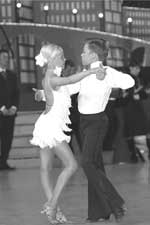
In the last decades, with development of dances in the West and carrying out a set of the championships, ballroom dances from aristocratic life passed into the category of a competitive sport. And though historically the concept "ballroom dances" unites many dances of various eras, in the last decades, speaking about ballroom dances, usually mean only 10 competitive dances grouped in two programs - West European and Latin American (respectively: slow waltz, tango, Vienna waltz, slow foxtrot, fast foxtrot and samba, cha-cha, point, paso doble, jive). As well as any other competitive look, sports dance - business very difficult, demanding big devotion. These are serious physical activities and individual occupations, effective and the difficult learned schemes shining in every sense suits and special footwear, strict judges and the gathered points for transition to the following class.

Ballroom dances are some kind of dancing literacy and a calligraphy. Now they incorporated huge number of different types of choreography, from national before modern dance.
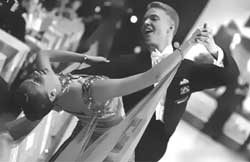
Today the dances of the last centuries which are historically executed at secular balls are again interesting and fashionable. The culture of balls is again demanded, and the phrase "ballroom dances" gains the initial value.
So-called "low" court dances in which there were no jumps and foot almost didn't rise over a floor: pavane, Courant, allemand. In "high" dances the dancing span (volt) and jumped (galyarda).
Bassedansa often call "walking" dances; they made as if small choreographic composition in which the dancing proved to be to the gathered society and showed the wealth, splendor of dresses and nobility of manners. The column court smoothly moved on a ballroom, squatting in deep bows.
The most widespread among bassedans I was ball бранль: the mass dance which is often connected with the game moments.
Branl - (from fr. branler - to move, be shaken), ancient French dance, originally national, round, appeared in Renaissance. In various provinces there were characteristic types national бранля, with the name by the name of places of its birth or to a distinctive sign (бранль laundresses, Breton бранль, etc.) Branli were simple, double, cheerful, imitative.
Later this country a form gets into halls of feudal castles and appears бранль ball, court. It differed in a large number of bows, in it there was more smoothness, the rounded-off movements, ceremoniousness whereas in national dance there were more otstukivaniye. The magnificent court clothes gave to dance stiffness.

The word "branl" characterizes not only type of dance, but also one of its movements - rocking of the case. Idle time бранль - a source of many appeared late saloon dances. Despite dancing poverty of movements бранля (4 small steps, the last with a foot pristavleniye), set of suits, music, stately manners did бранль extremely interesting. In the province of Poitou from бранля gradually there was a minuet.
Waltz – Boston (according to the name of the city of Boston, USA) - the American pair dance, popular in the 30th of the XX century, the predecessor of later slow waltz. For music of a waltz Boston lyrical sounding, an accurate rhythm, emphasis of the first quarter of muses are characteristic. size 3/4.
The fine sample of a waltz Boston is in R. M. Gliere's ballet "Red poppy".
The ball dance created in the XX century when the combined compositions had great success. Consists of two parts: gavotte and waltz. A link is bow. Muses. the size of the first part 4/4, second - 3/4. It is executed at dancing-parties and balls.

The ball dance of the XIX century, as well as Polish mazourka created by the principle of a combination fashionable at that time in one dance of movements, different in character; a certain composition on 32 steps. Muses. size 3/4. Consists of two parts: mazourka and waltz. It is executed at dancing-parties and balls.
The ball dance constructed on the stylized movements of the Hungarian national dances available to mass execution. Clearness of movements, restraint and at the same time a temperamentnost, a set of peculiar transitions, speed change, blows of heels and the general game nature of dance do it pleasant and favourite by many.
It became popular in Soviet period, it is executed at dancing-parties to this day.
The gavotte - (from fr. gavotte), ancient French dance, originally national, round, the two-submultiple size, is known since the XVI century. Muses. size 4/4.
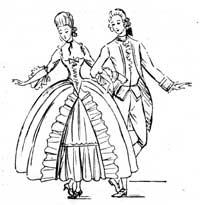
In the XVIII century receives a rebirth, but comes to ballrooms not since rural holidays, and from a scenic stage, arranged by a skilled, professional hand. Along with a minuet I became favourite affected and pretentious dance. It consisted of easy, small steps on semi-fingers and very refined curtseys. All this was combined with graceful, but elaborate poses and quiet movements of hands. The main pas of a gavotte - "the Hungarian step" - consists of twofold removing of a foot in the IV air position, forward or back. The foot moves, being softly and smoothly unbent that demands special training.
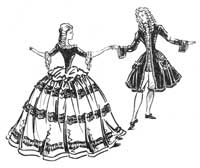
Thanks to a combination of excellent music to the original dancing contents the gavotte by right is considered historical dance. Painting, poetry, a sculpture, seeking to transmit spirit of gallant XVIII century, often addressed to the image of this dance.

Presently it is executed at balls as a part of the combined dance "waltz gavotte".
Gallop - (from fr. galop), ball dance at prompt speed with the spasmodic movements, and also music to such dance. Muses. size 2/4. Gallop appeared in Hungary in the XVIII century, and universal distribution gained in the 30-40th of the XIX century. Gallop often serves as a component, is frequent the conclusion of dance. The last figure of a quadrille began and came to an end with it. It was applied in operas, operettas and ballets. Character differs in big dynamism, the movements easy and sliding, they are simplest and are quickly acquired, than and its considerable success speaks.
Ancient Italian dance of Renaissance, fast, cheerful, muses. size 3/4. Originally it was danced at moderate speed and executed usually after a pavane. Galyarda - bright, live, with technically difficult jumps dance. In it more, than in other court dances people's movements remained. Ease and vivacity with which dance was executed, didn't exclude known refinement which needed to be kept even at fast turns. Performers of a galyarda could alternate, change and complicate at discretion the movements, as if competing with each other in dexterity.

Contains in a galyarda many movements which passed into new dancing forms. As a kind of a popular galyarda the dance "romaneska" or "five pases" is known.
Quadrille - (from fr. quadrille - four), national mass and ball dance of the XIX century, mobile, muses. the size 2/4, belongs to country dances. The homeland of this dance England from which it at the beginning of the XVIII century got to France is considered. The quadrille is obliged by the distribution and popularity to Paris. French changed dance to the taste, without having forgotten to add the word "French". In the 70th of the XIX century there is fashionable an English quadrille a lansye.
4 or 8 couples which formed a quadrangle - carre participated in a traditional quadrille. If steam was more, settled down in some caret. (In the Middle Ages the quadrille is the small group of the riders participating in tournament, which was settling down on four parties of the place which is taken away for a duel). Possibly, the military origin of a quadrille explains its popularity among officers at the beginning of the XIX century. Later two lines were built, and each line of couples serially danced each figure of a quadrille.
In a quadrille there were 6 figures, they turned on the chassis, rises on semi-fingers, gallop, transitions. Figures of a quadrille demanded brisk, graceful and graceful execution. The manager of a ball could create various dancing constructions at discretion. The dancing technology of execution of a quadrille was brought to perfection, and the movements were ideally finished.
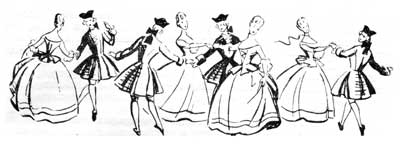
The ancient French quadrille was the center of attention and a basis of each ball. For one evening it could be executed several times. Workmanship was serious test for dancing, the quadrille was watched by all eyes of the hall! The quadrille had also educational value: it accustomed to good manners, to ability is musical, accurately and easy to move.
For two hundred years dance underwent many changes: figures became simpler, there were usual daily steps. The quadrille turned into dance of the rest necessary among fast waltzes, galop and Poles.
In the people the quadrille changed, improved and created decades anew. It got peculiar movements, drawings, manner of performance, having taken from saloon dance only some features of constructions and the name. The Russian people made a quadrille various on drawing, having entered into it many figures of the Russian round dances and dancings. The quadrille square, linear, circular differs. It is executed at dancing-parties and balls.
Country dance - the name collective, it united the same dances - a quadrille, англез, экоссез, a grossfater, a lansye - constructed on a caret or on the line where the even number of couples stood against each other.
There were they for the first time in England in the XVII century and from there were borrowed by all European people. "Country dance" - in English "country dance" - means "rural, rural dance". As well as many other dances, has the primary source national dances. The movements of a country dance were constructed on pas chasse, balance, pas de basque and gradually became complicated. The number of their figures reached several hundred.

The success of country dances is explained by that could execute it at the same time everyone (if only there was an even number of couples), while old dances (a pavane, a minuet) were executed by limited number of couples. Country dances on the type and the dancing contents were more interesting and more live, than many ceremonial dances. From here and great success of country dances which within nearly two centuries were steadily executed at balls of all countries and all estates.
Kotilyon - (from fr. cotillion), the ball dance of the French origin known from XVIII century, received popularity in the XIX century. Complication of its composition and emergence of a huge number of figures belongs to the same time. Any ball in the XIX century didn't take place without kotilyon.
Kotilyon at first was executed at the end of a ball as farewell performance of all participants in favourite dances, and then became the center of a dancing-party. Kotilyon very much reminds the mass dancing game headed by one couple which appointed an order of figures.

Dance included the movements of a waltz, a mazourka, the Pole. Sometimes котильон it was executed between quadrille figures.
Managers of balls brought into fashion котильон with accessories (various subjects). A variety of these subjects and the imagination of the manager of a ball created a set of new figures, is more exact than the entertainments and games with things connected to dances. More than 200 figures of a kotilyon, for example, "Chairs", "Flowers", "Cards", "Pyramid", "Mysterious hands", "Game of butterflies", "Mutual service", etc. are mentioned in some sources.
"Kotilyon - the tsar of dances, an unvalued voodushevitel, without which ball not a ball without which dancing vainly look for for what arrived: variety, cheerfulness, lack of any equipment, good joke, unexpected effects. It is dancing game where not one feet work, but in particular wit" (Petrova M. Yu. exercises the wit. "The Petersburg latest self-instruction manual of all public dances" S-Pb, 1883).
The Polish national, then ball dance, according to the name of the city of Krakow. Muses. size 2/4, live, pride dance. The movements of dance are simple, but are vigorous that points to its national origin. At first it was danced only by men: "knight" and his "armourbearer". Then began to dance together with the lady: it - smoothly and gracefully, it - with sharp pritopa. In the krakowiak the main movements are similar to the movements of a mazourka - with three serial percussions by all foot in a floor; and the first and third притоп has to be stronger than the second.
The composition of dance most known today is constructed by the teacher N. L. Gavlikovsky and connects characteristic elements of the Polish dance to a waltz. According to musical the sizes the waltz part (second) is executed not on 3/4, as in a usual waltz, and on 2/4.
It is executed at dancing-parties and balls.
Courant - (from fr. courante - running, flowing), the French ball court dance, muses. the size 3/4, belongs to bassedansa. During XVI and the beginning of the XVII century, on an equal basis with a pavane, Courant was the most favourite saloon dance. It was "slow important dance, more other dances inspiring feeling of nobility". I differed in difficult, intricate figures.
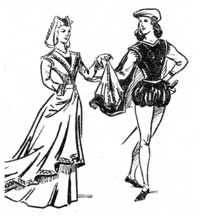
The peculiar character consisting in "an eternal current forward" has Courant as means the word of "kurant". At the end of the XVII century it was forced out by other, less solemn and more mobile dances.
It it is in French perfect
I could express and I wrote;
Easily I danced a mazourka
Also I bowed easy;
Than that you have more? Light solved,
That it is clever and very lovely.
A.S. Pushkin
Mazourka - (from польск. mazurek - the name of inhabitants of Mazoviya) - prompt and incendiary ball dance.
Mazourka sources - in the national Polish dance to Masur which appeared in the XVI century remarkable on beauty and a variety of movements. In Europe the mazourka becomes known by the beginning of the XIX century (dancing-masters gave to national dance saloon character) and the greatest distribution gains in Russia. Anywhere (except Poland) with such gloss and skill didn't dance a mazourka, as in Russia. Its studying demanded much more time, patience and arts, than studying of other dances.
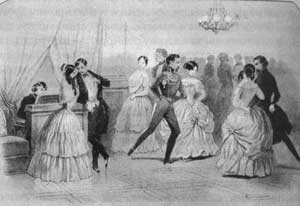

Russian mazourka. From the French lithograph of the XIX century.
Everything in a mazourka supports an image of the brilliant cavalryman: both special bearing, and elastic step, and gallantry of the courteous gentleman. Successful execution of dance depended on it. He chooses figures and changes speed. A mazourka - dance of dashing equestrians and their gentle ladies. Strong blows a heel (a horse prishporivaniye), sharp waves a hand over the head (a tension of reins), "a lame step" (a reminder on wounds) were elements of men's party, and ladies have an easy jogging on semi-fingers and in general demonstration of weakness and fragility. The lady has to be able to fly easily on a hall, to be able to grab the movements and transitions offered by the gentleman. During dance of the man fell by one knee before the lady as if wishing to help it to descend from a horse. Gentlemen flaunted before the ladies, fascinated and won them.
By the way, describing execution of a mazourka, authors of works of art mention spurs - a subject of equipment of the rider. It wasn't accepted to appear on a ball in boots with spurs (since they could damage a dress of the lady). But in spurs there is something poetic, and in the image of the gallant military tinkling spurs there was a lot of romanticism.
Figures of dance were various and numerous, and free improvisation of movements did dance bright and fascinating. The mazourka always was in the center of each feast, for it waited, for it prepared.
After the mazourka received constant "registration" in ballrooms, dancing-masters thought out all new and new figures and even types of a mazourka. There were a waltz mazourka and a quadrille mazourka, it was connected to the Pole, used in the kotilyena. In a pas de trois the mazourka makes the whole part of dance. One of mazourka figures - "Health" - was executed with the Champagne glass in a hand. The first office of a ball usually came to the end with a mazourka.
It is hard to say, today the mazourka would be so well-known, if not that special role which was played in development of its musical form by the Polish composer Frederic Chopin. He wrote more than 50 fine mazourkas. That Chopin for a mazourka made is comparable only with Johann Strauss's role in a waltz.
Minuet - (from fr. menu - small) - ancient national French dance. Muses. size 3/4. I appeared in the XVII century from a national branlya which consisted of small steps (pas menus). The movements бранля will be stylized, embellished; measured small steps connect to smooth knee-bends and prudish curtseys. Lyudovikov of XIV and XV it is possible to call reign the present era of a minuet. In Russia it was executed on Peter I's assemblies and at noble balls at Catherine II.
Any dance XVI-XVII of centuries didn't enjoy such popularity as the glorified minuet which is the conventional model of saloon dancing art.
"The minuet is a dance of kings and the king of dances", - historians of dancing art so called it. Was considered: "who well dances a minuet, that does everything well".
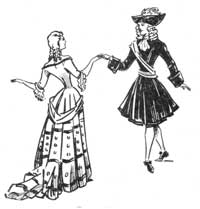
- the beginning of the XIX century many the dance teacher believed in XVIII that for bearing of a bearing and development of graceful manners it is necessary to train long time of pupils in a minuet and not to hurry with learning of new dances until the minuet perfectly isn't executed. One their largest Russian ballet masters and teachers A. P. Glushkovsky said that the minuet "accustoms to bow dexterously, directly to go, gracefully to give a hand, and the pupil receives perfect bearing of all body".
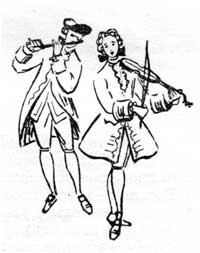
The main line of execution of a minuet is the tseremonialnost, gallantry and solemnity. The minuet step - a pas грав (pas grave) - very smooth, each movement follows from previous without interruption. It isn't so simple to reach it. But it is impossible to forget that in those days it was accepted to be trained in dancing skill long; one bow of a minuet was studied month, passed years before decided to execute dance on court to a ball. Hands of the dancing - soft, plastic, dorisovyvat minuet poses.
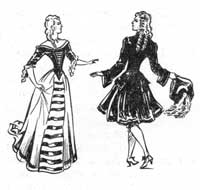
The magnificent clothes obliged to the slow movements. "Dancing happened a little because the minuet was dance premudreny; constantly continually that either sit down or bow, and that is careful; it isn't enough of it, protect the tail that it wasn't torn off, and look that most not to get to others tail and not to get confused". ("The Russian messenger", 1878)
Minuet didn't dance around the hall, its drawing varied in the smooth rounded-off lines in the form of the letters S and Z, figures 2 and 8.
All outstanding composers used a minuet as a fertile subject for the creativity. Outstanding ballet masters created new pases of a minuet. There were "the king's minuet", "the queen's minuet", "a yard minuet". In the XVIII century, with acceleration of speed there was a fast minuet.
The minuet was written by almost all composers of instrumental music, in particular the minuet received art processing at Haydn, Mozart, Beethoven. From the Russian composers outstanding minuets were written by Glinka and Rubenstein.
Minion - (from fr. mignonne - pleasant), pair ball dance of the end of the XIX century, a certain composition on 16 steps, muses. size 3/4. It is constructed on the characteristic movements of a waltz, it is close on character to a figured waltz. It is entered into use by the famous dance teacher N. G. Gavlikovsky. Includes the movements: balance, path and waltz minion (step glide paths and waltz turn). It is executed in a soft and quiet manner.
Pavane - (from armor. pavo - a peacock), ball dance of majestic and solemn character, belongs to bassedansa, slow speed, muses. the size 2/4, one of the oldest historical dances known to us. Along with the kuranty it was widespread in Europe in the XVI century. I appeared in Spain as ceremonial procession, I got to France where remaining exclusively court, I changed and became complicated. Dance aimed to show to society a stateliness dancing, grace of manners and movements, richness of suits. The movements of a pavane is the course of the flaunting peahen. Under music of a pavane various ceremonial processions were carried out.
The pavane was danced at the same time by one or two couples. The strict order in alternation of couples depended on an origin and the social standing dancing (at first the king and the queen, then other notable persons). The pavane enjoyed wide popularity to the middle of the XVII century when conceded the place to a minuet.
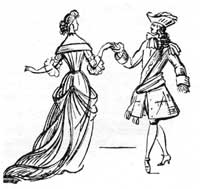
For dance small steps, knee-bends and the fixed poses are characteristic. Padegras is popular at dancing-parties and balls.
Padekatr - (from fr. pas de quatre), quite graceful ball dance belonging to number of the most widespread in the end of XIX - the beginning of the XX century. Improved and updated, it is entered into use by the soloist of the Petersburg ballet and the famous dance teacher N. L. Gavlikovsky. Padekatr consists of steps glide paths and waltz turn. Feature of a padekatr is execution of a waltz at a rate of 4/4 (i.e. quicker). Dance occupies 4 steps. The first and second step consist each of four steps, as gave the name to dance. Dance is very short, but is extraordinary elegant and beautiful.
Treats group of the classical ballroom dances grouped from dancing steps, lungs, the sliding movements and poses. It is executed at dancing-parties and balls.
Padepatiner - (from fr. patineur - dance of skaters), pair ball dance of the established composition, moderately fast speed, muses. size 2/4. Lungs, the sliding steps and poses of dance imitate the movements of skaters.
Padespan - (from fr. pas d'Espagne), pair ball dance of the established composition, moderately fast speed, muses. size 3/4. Within several decades created in 1898 by the actor of the Bolshoi theater, the Russian choreographer A. A. Tsarman, падеспань was one of the most favourite Russian dances. It is constructed on simple elements of the Spanish dance.
It is executed at dancing-parties and balls.
Pas de trois - (from fr. pas de trios - dance three together), in the classical ballet - dance of three performers, and also ball dance of a certain composition on 24 steps. Consists of three parts, various on character and speed: minuet, mazourka and waltz. Muses. size 3/4.
As well as падеграс, it was composed in Russia at the end of the XIX century by the Russian ballet masters E. M. Ivanov and A. P. Bychkov. Dance had a deserved success along with other dances which brought up good manners, grace, grace and musicality.
"Polonaise" ("polonaise") in French means "Polish". It is the Polish solemn dance procession, I came from national mass dances – walks. Muses. size 3/4. I gained fame in the XVI century as ceremonial court dance. In those old times it was "represented" rather, than danced. Court ladies at representation to the king formed a procession which was accompanied by majestic music; such procession entered tradition and began to open all state ceremonies, and procession developed into dance. In Russia it was called "walking conversation" since during dance performers could conduct conversation. Unlike the majority of saloon dances the 1st floor. XVIII century the polonaise didn't give in during the subsequent eras and strongly took a place of the first, "imperial" dance at all balls.
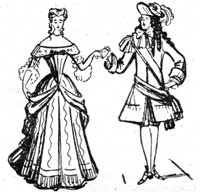
This dance the host opened any ball. The gentleman of the first couple (with the most honourable lady) was a leader and differed in exclusive elegance of movements. The first couple set the movement which repeated all column. Having begun in the palace, dance proceeded in "one thousand whimsical windings" through all apartments, in a garden or in the remote drawing rooms where the movements became more relaxed. The polonaise "wasn't senseless walk at all, all society enjoyed the contemplation, seeing itself such fine, notable, magnificent, courteous. Dance was a constant exhibition of gloss, glory, value". (F. Liszt)
The polonaise is created (a characteristic exception!) with the purpose to draw attention to the man, to emphasize his shchegolsky look and a proud bearing. Even the name of dance in the original - Polski - a masculine gender. During that time magnificent fabrics, jewelry and bright colors were widespread at men not less, than at women. Special ability demanded to remove a headdress during a polonaise, to shift it from one hand in another, to touch a saber hilt etc.
The beginning of a polonaise was marked the riturnely. A dance step soft, graceful and not changing (despite fancifulness and complexity of all composition), with deep smooth knee-bend on the third quarter of each step. The connected hands of the gentleman and the lady highly didn't rise. The case dancing slightly will be deployed to the partner, the faces of partners are also turned to each other, and this situation remains throughout all dance. The case has to remain strictly tightened, a bearing - pride, steps alternate with smooth knee-bends and bows. Everything is executed with feeling of big internal advantage and a step. In dance there are no fast or intricate movements, but at the same time any dance doesn't demand such strict concentration as a polonaise. Here the smallest awkwardness, the easiest uncertainty in feet, the slightest missing in a step are visible clearly. To pass with nobility, grace and simplicity when from all directions look at you!.
After the host solemnly opened evening, any of guests had the right to take its place with his lady and to become thus at the head of a train. Ladies, changing gentlemen so many time, how many new gentlemen invited the first of them, followed in the same order, gentlemen replaced each other, and happened, being at the beginning of dance ahead it could appear the last. The gentleman becoming at the head of a column tried to surpass the predecessor by unknown figures which it forced to make.
The role of a polonaise consisted not only in representation of guests each other, but also in creation of a certain atmosphere: "Polish" helped to be adjusted on a dancing-party which demanded big choreographic skill.
Smart dance of aristocratic balls immortalized itself and in music; Chopin, Glinka, Oginsky's polonaises are brilliant! The polonaise occurs in Tchaikovsky's opera "Eugene Onegin", "Ivan Susanin" of Glinka. Unlike other dances which melodies are sung, the polonaise was always a tool genre.
Ancient Czech dance, but not Polish as it seems from the name. Muses. size 2/4. The word "Pole" comes from the word "pulka" that "half" in Czech means. And it is valid, the main movement of this cheerful dance consists of two half steps connected by a prefix.
The ball Pole was born from national Czech dance and in many respects kept its lines. Any holiday in the Czech Republic doesn't do without fervent and cheerful Pole. In the first half of the XIX century the Pole was brought to France by the Czech choreographer Josef Neruda.
The 40th years of the XIX century were time of rough hobby for the Pole across all Europe, including and in Russia. Its success eclipsed even a waltz. "All - from clothes to dishes - began to be called as Pole". Cheerfulness, playfulness, ease, not characteristic for dances of that time, promoted triumphal procession of the Pole worldwide. The Pole unites the embraces peculiar to a waltz, with improbable energy and vital force. Carelessness and ease - its nature. New dance allowed to dance spontaneously and only for pleasure. Subsequently there were some kinds of this dance, however, the initial Pole endured all the successors.
Like all ballroom dances created on a national basis, the Pole well adapted to new conditions of execution in a dance hall. All its charm is invariable - in a cheerful rhythm, in fast and the easy jumping-up movements and turns of dancing couples. In the Pole various figures with which the dancing can vary voluntarily are used.
Music of this dance was appreciated by many composers. Subjects of the Pole sound in operas, symphonic and chamber works. Johann Strauss son, undoubted "the king of waltzes" became also "the king of Poles" (163 compositions). Tchaikovsky has beautiful Poles, "The Italian Pole" of Rachmaninov is unique.
The Pole strongly entered dancing art of many people. It changed, getting national coloring, but always in it there was a combination of mobility and force of man's dance to coquettish grace female. The Pole Serbians have a national dance, Slovaks, Hungarians, Poles. The majority of dances of Baltic are constructed on the basis of the Pole. It too played a big role in distribution of the ball Pole worldwide. There are Poles German, Finnish, Swedish and even the Brazilian.
The Pole is also now popular, her dance at competitions, balls, dancing-parties.
Pair ball dance of the Soviet program, is constructed on elements of the Russian national dances, a certain composition, consists of 2 parts - slow and fast (on 16 steps), muses. size respectively 4/4 and 2/4. It is executed at dancing-parties and balls.
Pair ball dance of the Soviet program, muses. the size 2/4, rate of 32-34 t/min., a certain composition on 16 steps. "the Russian step" with a pause is the cornerstone of dance usual, and dance podkupayushche is simple and pleasant. It is executed at dancing-parties and balls.
Ball dance of the end of the XIX century. Muses. size 3/4, speed moderately fast. By right treats dances of ball classics. Studying it, performers pass necessary "school" of plasticity, get a good bearing, softness, ease of rotation, the beautiful movements of hands. Now it is modified and very popular at dancing-parties and balls. "Figured" is a waltz into which composition besides the main movements - paths and rotations - are included various elegant elements and a pas. Dance consists of 4 figures and occupies 32 steps of music.
Also extended composition under the name "big figured waltz" is known.
The recommended literature on dances
Maria Vasilevskaya "Dances from And to I" the Book about dances for laymen
We recommend that you look at the popular sections of the site myvaleology.com: MENU with a description of the sections | |||
| SOCIAL | DONATION | MY DIET | MY SPORT |

|
Release all4e8 |
||
Copyright © VZOJ 2023. All rights reserved. When reprinting or quoting myvaleology.com materials please put a link to the site myvaleology.com :
<a href="https://myvaleology.com">Healthy lifestyle</a>